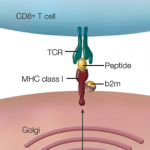Individuals who experience contusive spinal cord injury can suffer extensive disability from which recovery is difficult. Experts blame the lack of recovery on the limited functional plasticity and neuronal regeneration of the adult nervous system.
In addition, research has revealed that glial-derived chondroitin sulfate proteoglycans (CSPGs) act as a barrier to neuronal regeneration. Specifically, CSPGs are up-regulated within the glial scar and perineuronal net after injury and act as repulsive components of the extracellular matrix, thereby preventing axonal regrowth and sprouting. Researchers have recently identified several receptors for the inhibitory glycosylated side chain of CSPGs. These include protein tyrosine phosphatase σ (PTPσ), its sister phosphatase leukocyte common antigen-related (LAR), and the nogo receptors 1 and 3 (NgR).
Bradley T. Lang, PhD, a recent graduate of Case Western Reserve University School of Medicine in Cleveland, Ohio and colleagues, identified a way to overcome the CSPG barrier and published their results in Nature.1 Dr. Lang was a graduate student in the laboratory of Jerry Silver, PhD, a senior investigator of the paper. The Silver Laboratory has developed an in vitro model of the inhibitory extracellular matrix that forms after spinal cord injury. Dr. Lang and colleagues began the current paper by describing the role of PTPσ in this model system.
The investigators report that PTPσ stabilizes growth cones within CSPG-rich substrates and, thus, converts the growth cones into a dystrophic state. PTPσ is evenly distributed in a punctate pattern within motile axons and growth cones. It concentrates, however, in the dystrophic stabilized growth cones. The investigators concluded that PTPσ plays an important role in mediating the growth-inhibited state of neurons.
The researchers then analyzed the structure of PTPσ. They were able to identify a highly conserved wedge domain that was 24 amino acids long. They created a membrane-permeable peptide mimetic of the PTPσ wedge domain. They called the peptide intracellular sigma peptide (ISP) and found that it bound to recombinant human PTPσ. The investigators then used ISP to further explore recovery from spinal cord injury. Specifically, they asked whether ISP could release CSPG-mediated axonal inhibition in their in vitro model. They found that ISP did, indeed, bind to PTPσ and relieve CSPG-mediated inhibition.
They next studied the effect of ISP in rats. After determining that ISP could cross the blood–brain barrier, they systemically delivered the peptide over seven consecutive weeks to rats whose spinal cords had been injured. They found that treatment with ISP substantially restored serotonergic innervation to the spinal cord below the level of injury. When the ISP-treated rats (but not control rats) were given the 5HT receptor antagonist methysergide at 14 weeks after spinal cord injury, the rats experienced reduced locomotor and urinary function, suggesting that serotonin was critical for the process of neuronal growth.
The investigators then characterized the functional recovery of the urinary and locomotor systems. Rats that received ISP had a twofold increase in void frequency at 12 weeks post-injury when compared with rats that received control treatment. Moreover, after ISP treatment, the rats had a significant progressive recovery of locomotion that began several weeks after injury. When the investigators tested the injured rats for three distinct behaviors (i.e., micturition, gridwalk and locomotion) using a blinded behavioral tester and a separate blinded treatment administrator, they found that the majority of ISP-treated rats (21 of 26) recovered at least one of the measured behaviors at Week 11.
The investigators were careful to note that ISP treatment did not lead to differences in lesion size, nor did it spare white matter. They concluded that ISP was not neuroprotective. They also did not observe any regenerating corticospinal tract fibers.
The authors suggest that their findings enhance investigators’ understanding of the role of PTPσ in mediating the growth-inhibited state of neurons after spinal cord injury. (posted 1/30/15)
Lara C. Pullen, PhD, is a medical writer based in the Chicago area.
Reference
1. Lang BT, Cregg JM, DePaul MA, et al. Modulation of the proteoglycan receptor PTPs
promotes recovery after spinal cord injury. Nature. 2014. Dec. 3. doi: 10.1038/nature13974. [Epub ahead of print]

